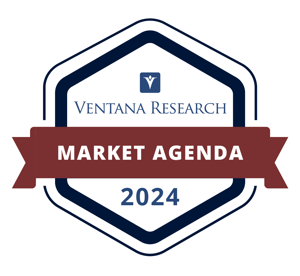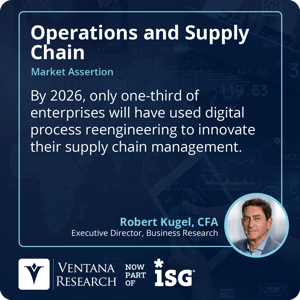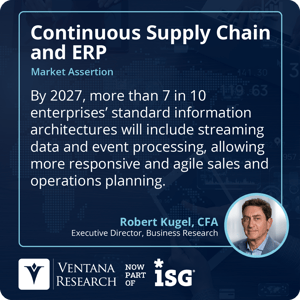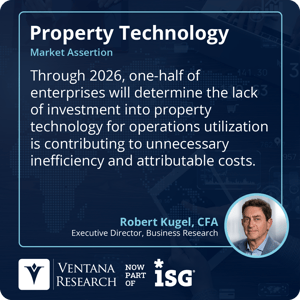2024 Market Agenda for Operations and Supply Chain: Seize the Opportunity
Ventana Research recently announced its 2024 market agenda for Operations and Supply Chain, continuing the guidance we have offered for more than two decades to help enterprises across industries derive optimal value and improved outcomes from business technology.
After three years of reacting to disruption, enterprises that have made the right investments and restructured operations are able to go on the offensive to seize opportunities sooner  and with greater intelligence. Readily available, innovative digital technology can help enterprises optimize operations by aligning customer demand with fulfillment of products and services via the supply chain, which is often not able to operate at expected levels. Effective use of analytics, collaboration, machine learning, planning and the Internet of Things (IoT) can increase supply chain agility through improved sourcing, manufacturing, distribution and logistics, dramatically improving the value of products and services to customers. Using performance management technology across the supply chain increases revenue while holding the line on costs. Artificial intelligence using machine learning (AI/ML) will have a significant impact on the effectiveness of enterprises. Ventana Research asserts that by 2027, one-half of supply chain management enterprises will have adopted some form of AI/ML to shorten planning and forecasting cycles and promote agility and resilience. Those that fail to capitalize on technological advances risk diminished competitiveness and agility in responding to shocks.
and with greater intelligence. Readily available, innovative digital technology can help enterprises optimize operations by aligning customer demand with fulfillment of products and services via the supply chain, which is often not able to operate at expected levels. Effective use of analytics, collaboration, machine learning, planning and the Internet of Things (IoT) can increase supply chain agility through improved sourcing, manufacturing, distribution and logistics, dramatically improving the value of products and services to customers. Using performance management technology across the supply chain increases revenue while holding the line on costs. Artificial intelligence using machine learning (AI/ML) will have a significant impact on the effectiveness of enterprises. Ventana Research asserts that by 2027, one-half of supply chain management enterprises will have adopted some form of AI/ML to shorten planning and forecasting cycles and promote agility and resilience. Those that fail to capitalize on technological advances risk diminished competitiveness and agility in responding to shocks.
Over the past three years, enterprises have discovered the power of technology to enable resilience for business continuity, agility to respond to a rapidly changing environment and the capacity to operate remotely. Digitizing operations and supply chain became a priority. Unfortunately, many of them continue to underinvest in technology. Ventana Research asserts that by 2026, only one-third of enterprises will have used digital process engineering to innovate their supply chain management.
the capacity to operate remotely. Digitizing operations and supply chain became a priority. Unfortunately, many of them continue to underinvest in technology. Ventana Research asserts that by 2026, only one-third of enterprises will have used digital process engineering to innovate their supply chain management.
We craft our annual market agenda using our firm’s expertise in business requirements, especially the complexities of accounting, tax and capital markets, combined with our knowledge of technology providers and products. As a result of our market research, we are able to offer insights and best practices to both the lines of business and IT as well as across industry verticals, providing guidance that will help every enterprise reach its maximum potential. Our practice of expertise is concerned with all aspects of Operations and Supply Chain, but we have six focus areas for 2024 including Continuous Planning, Continuous Supply Chain and Enterprise Resource Planning, Product Information Management, Property Technology, Supplier Relationship Management and Sustainability Management.
Continuous planning supports enterprise-wide, high-participation and collaborative planning processes, enabling enterprises to execute rapid planning cycles across all departments and business units. Technology such as in-memory computing, advanced analytics and interactive planning make planning processes faster and more agile. Planning cycles that once took days or weeks can now be accomplished in minutes or hours, providing executives with detailed answers to what-if questions in real time. Enterprises must shift from silo-based planning to continuous planning to achieve better results, and technology is available to smooth this transition. We assert that by 2027, all providers of sales and operations planning software will differentiate their offerings by the capabilities and accuracy of their GenAI functionality. Our Business Planning Buyers Guide assesses and rates software providers’ offerings and the potential of these systems to support supply chain and S&OP needs.
The Continuous Supply Chain and ERP
Ventana Research uses the term “continuous supply chain” to describe an approach that enables enterprises to manage interactions with the supply chain through more immediate and better-informed decisions using actionable information. Digital technologies increasingly can intelligently automate time-consuming tasks to help managers and executives achieve greater agility and support desired objectives. However, most enterprises lack the systems and processes for supply chain management and will require new investments to remain competitive. Technology can streamline product life cycle management as well as manufacturing and service applications to ensure optimal execution. We assert that by 2027, more than 7 in 10 enterprises’ standard information architectures will include streaming data and event processing, allowing more responsive and agile sales and operations planning.
and better-informed decisions using actionable information. Digital technologies increasingly can intelligently automate time-consuming tasks to help managers and executives achieve greater agility and support desired objectives. However, most enterprises lack the systems and processes for supply chain management and will require new investments to remain competitive. Technology can streamline product life cycle management as well as manufacturing and service applications to ensure optimal execution. We assert that by 2027, more than 7 in 10 enterprises’ standard information architectures will include streaming data and event processing, allowing more responsive and agile sales and operations planning.
Continuous supply chain and enterprise resource planning (ERP) systems use software to enable concurrent planning—the antidote to siloed planning—so plans are always in sync across the enterprise to support more nimble supply chain execution. Operationally, ERP systems are central to an enterprise’s handling of inventory transactions management. Today’s ERP systems and analytics take advantage of current technology to support greater agility, adaptability and resilience. ERP technology is evolving to enable a continuous supply chain approach for manufacturing and service industries. ERP in the cloud advances processes for service and supply chains and their efficiency. ERP also increasingly includes technologies such as collaboration and the use of artificial intelligence, using machine learning to support more efficient, accurate and rapid process execution while reducing the need for training. We will publish a Buyers Guide on Supply Chain Management and ERP to help enterprises assess and select software providers and address emerging requirements for modernization.
Product Information Management
Product information management (PIM) technology improves product experiences by enabling consistent management of product-related information used in business processes and by consumers. Enterprises are maximizing PIM to support a superior digital experience across supply chain operations and the product life cycle. These applications also enable more effective marketing. We assert that through 2026, one-fifth of enterprises will have connected a product information network with virtual agents supporting the enterprise and customers’ requirements for responsiveness.
The transition to the cloud is speeding the return on investment and helping enterprises provide excellent product experiences. There is also pressure for enterprises to take advantage of machine learning and robotic process automation. These technologies address product information quality by highlighting issues and opportunities for improvement. One aspect of that improvement is the distinct nature of product life cycle management that is not connected to PIM but should more directly share information together and across the supply chain. PIM systems enable enterprises to consistently manage product-related information used by business processes with ERP, product life cycle management and supply chain systems coordinated with suppliers and the supply chain.
To provide guidance on effective PIM trends, we will publish new market research to identify best practices and a Buyers Guide to assess and rate technology providers’ potential to meet emerging product needs. We will also include PXM for customers versus supply chain, examine the platform for PIM and PXM support and provide a guide on product intelligence and analytics software providers.
The continued shift to hybrid workplaces for a portion of the workforce challenges traditional corporate office environments not prepared for this change. Where people shop and live have put a spotlight on the importance of the use of property technology for increasing efficiency and experiences in the interactions across parties. Moreover, higher real interest rates will continue to upend commercial real estate ownership and portfolios. Both trends will force property management processes to be more efficient and better able to address shifting market requirements. In response, owners will need to replace existing, immature and inefficient technologies for both businesses and residential real estate with more modern systems.
Property technology applies digital applications to the management and use of real estate to support owner, landlord and tenant relationships. Too many enterprises rely on manual or inefficient web-based form processes that are cumbersome for property owners and do not deliver a 21st-century customer experience for lessees. We assert that through 2026, one-half of enterprises will determine the lack of investment into property technology for operations utilization is contributing to unnecessary inefficiency and attributable costs. The digital revolution in property management will support a more agile and predictive approach to managing locations, using technologies such as the IoT to continuously monitor properties as well as work automation to supervise and support onsite processes.
inefficient web-based form processes that are cumbersome for property owners and do not deliver a 21st-century customer experience for lessees. We assert that through 2026, one-half of enterprises will determine the lack of investment into property technology for operations utilization is contributing to unnecessary inefficiency and attributable costs. The digital revolution in property management will support a more agile and predictive approach to managing locations, using technologies such as the IoT to continuously monitor properties as well as work automation to supervise and support onsite processes.
Supplier Relationship Management
Supplier relationship management (SRM) evolved out of an objective to sustain a mutually beneficial working arrangement with suppliers (rather than a combative one) to make interactions more productive. SRM software focuses on evaluating these relationships with an emphasis on having the necessary information to determine which suppliers are the most important to the enterprise in terms of continuity and performance so as to ensure a smooth working relationship. Essentially, SRM systems facilitate transactions and achieve better results by making buying enterprises easier to do business with. Ventana Research asserts that by 2026, the category of supply relationship management will adopt AI to best identify exceptions and opportunities to improve the satisfaction and value of suppliers.
Sustainability practices are consistent with the conservation of resources, which results in greater efficiency. The focus on environmental, social and governance (ESG) issues brings with it increased compliance costs in accounting for and reporting on these topics. However, insofar as it sets out environmental impact measures it also calls attention to ways in which enterprises can reduce waste and associated input costs in their operations. Technology can reduce compliance burdens and ensure that greater efficiency objectives are achieved. At the same time, enterprises have a long way to go. Ventana Research asserts that through 2026, one-half of enterprises will have insufficient data and software to adequately measure their ESG metrics to inform their governance, strategy risk management and targets. Increased visibility for ESG issues, and especially the need for greater intelligence in achieving ESG objectives including supply chain impacts, increases the importance of these systems. Our Buyers Guide on ESG and the operations and analytics required to help assess and select software providers will be published in 2024.
Subscribe to our Ventana Research community at no cost to stay up to date on our 2024 research efforts. Check out our Operations and Supply Chain expertise and focus areas for the detailed agenda and continuously updated 90-day calendar as well as more research facts and best practices.
Regards,
Robert Kugel
Authors:

Robert Kugel
Executive Director, Business Research
Robert Kugel leads business software research for Ventana Research, now part of ISG. His team covers technology and applications spanning front- and back-office enterprise functions, and he personally runs the Office of Finance area of expertise. Rob is a CFA charter holder and a published author and thought leader on integrated business planning (IBP).










